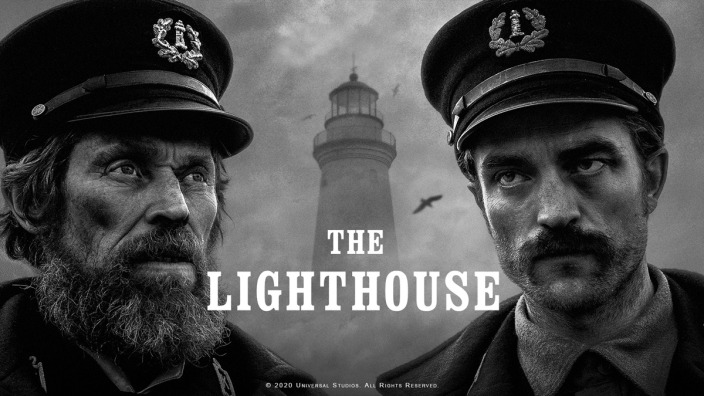First premiered in Singapore at the Singapore International Film Festival in November 2019, The Lighthouse had a limited release at The Projector last month, but if you conspired to miss it so far, you will be delighted to know that you can watch one of the finest movies of 2019 now on CATCHPLAY+. Here are four reasons why you must see it!
Robert Eggers is a genre unto himself.
If you do not know who Robert Eggers is, you might have at least heard of his frightening horror film, The Witch (2015), especially if you are a fan of the genre. Instead of 1630s New England, witchcraft and black magic, we are propelled forward in time to the 1890s onto a mysterious island with a lighthouse, where two keepers work to maintain it until someone else comes to relieve them of their duties.
This is another nightmarish tale to savour in just Eggers’ second feature film to date. Like The Witch, The Lighthouse is an accomplished work with a distinct visual style (more on that later) and features characters who speak a different kind of English. In an almost poetic fashion, the language spoken has an archaic ring to it, what with the copious use of “-eths” and arcane phrases. In fact, you might have to turn on the English subtitles to be able to better understand and appreciate the dialogue!
Eggers seems to have crafted out a subgenre of his own, exploring old-world horror, violence and psychological trauma in these two films. His next film, The Northman, which is currently in pre-production, will bring us way, way back in time to 10th century Iceland in what has been billed as a ‘Viking revenge saga’. In other words, it sounds like his kind of thing.

Robert Pattinson and Willem Dafoe are two drinking buddies that you didn’t know you needed.
The Lighthouse is certainly not the feel-good movie of the year, but with Robert Pattinson and Willem Dafoe in the (light)house, do expect sparks to fly once they down one bottle too many. You are, of course, not encouraged to do the same, because while they may have a giddily good time in each other’s company, things will start to get baffling. You will need all of your brain cells to process what is happening to them.
If you are still not convinced by Pattinson (who will be the next ‘Batman’), go see this and Good Time (2017). Dafoe, of course, is always good yet still underrated after all these decades. He plays a gruffy-looking old man who is a veteran lighthouse keeper seemingly with secrets of his own; Pattinson is his novice sidekick who finds it difficult to adapt to repetitive menial labour and the harsh weather conditions. At least they have feisty seagulls for company.

Cue maximum claustrophobia.
The Lighthouse could be one of the most claustrophobic films ever made, and this is thanks to its distinctive visual style. First, it is shot in black-and-white, reminding of eerie gothic-type pictures set centuries ago. But more importantly, it is presented in the 1.19:1 aspect ratio.
For those of you who have forgotten your primary school mathematics, 1:1 represents a perfect square image; hence, a 1.19:1 image is almost like a square, containing the events in the film into a tight, constricting space. (In contrast, modern blockbusters that you see today such as the ‘Marvel’ movies usually have a much more rectangular, ‘widescreen’ image at 2.39:1). Eggers has to thank his cinematographer, Jarin Blaschke (who earns the film’s only Oscar nomination for Best Cinematography), for the haunting and crisp aesthetic, and playing with light and shadow to dazzling effect.

Oscar-nominated cinematographer Jarin Blaschke (centre)
'Id' sounds terrifying.
If you enjoy mysteries enshrouded in myths that feel surreal and hallucinatory, then The Lighthouse will whet your appetite. Realities become unreliable, and the identities of Pattinson’s and Dafoe’s characters also become unstable over time. The film is a terrifying Freudian nightmare, and certainly feels like how the Id might sound like if it manifests as part of the cinematic apparatus.
In fact, one of the most impressive aspects of Eggers’ film is his detailed, immersive use of sound—be it foghorns blasting, machineries clanking, winds howling, waves crashing, rain pouring—and topping them off with suspenseful strings and brass music. These are blaringly loud and frightening. But there are soft ones as well set against complete silence—a grandfather clock ticking here, a leaking pipe there, plus Dafoe’s character’s way-too-nonchalant farting (seriously this one is hilarious!).
The Lighthouse is a compelling film, precise in its use of both cinematographic and aural techniques, that immerses us into shifting states of mind. It is a film about our deepest fears and desires, as well as Man’s instinctual quest for the elusive truth. When one is blinded by the light, one can see everything and nothing at the same time—and that is scarier than any kind of pitch-black darkness.






